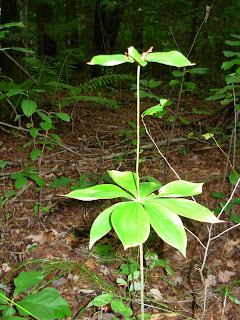The one with just the foliage looks like it could be Wild Sarsaparilla, Aralia nudicaulis, a member of the Ginger family. It will have to wait til next spring to be identified, as that is when it will be in bloom. It just blends in with all the other undergrowth at this time of year, so I hardly even noticed it.

This is the plant I was so surprised by.

It is growing in a little colony, with about 10-15 plants surrounding a tree near the brook.

When I first saw it the tendrils coming out of the top were green with red tips.

I wasn't sure if it was a bud forming or what. When I tried to look it up, as the guidebooks are sorted by flower color I had no luck in checking out all the red flowers. The next time I went out the tendrils and part of the top cluster of leaves had turned red.



Also, one of the plants had a berry on it!

So now I looked in the red/pink flower section and still no luck. I just got frustrated and decide to wait to look into it another time. Tried again, to no avail. Then I just got so impatient with trying to identify it that I went through the guide book from the first page of pictures and started to work my way through the guidebook. Luckily, it was on page 2, the 3rd photo in the book!! And this is the section with green flowers!! This plant has flowers early in the spring, so what I though was a bud was the stem for the fruit. And on top of one of them was a great berry!

I thought the double layer of whorled leaves just so striking. Only the more mature plants have the double level of leaves. This is Indian Cucumber Root, Medeola virginiana, a member of the Lily family. In researching it, I discovered that the root is edible, having been a mainstay for American Indians (thus the name). And on my foraging hike there were several patches with lots of these plants so we got to taste the root. Only the double decker plants have a large enough root to make it worth the taste. As they are scarce plants, the guide took one with a berry so that the berry could be planted to produce a new plant for next year. The root itself was only one inch long, but it did taste like cucumber! I would not take the ones up from my woods as there are so few. It was fun to taste it. I might get more from the wild some day if I come across a large enough patch. Don't want to use up any plant that is not plentiful.


3 comments:
Hi Marna
I've seen some of those in the woods around my house - they are pretty foliage.
Hope all is well.
Sheila
Way cool! I haven't seen any of those around here. Do they grow in areas that are moist?
They grow in moist deep woods. They are scarce and aren't even listed in my native plants book.
Post a Comment